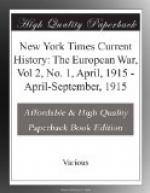It is just here that the value of neutral participation will come in. Whatever ambitions the neutral powers may have of their own, it may be said generally that they are keenly interested in preventing the settlement from degenerating into a deal in points of vantage for any further aggressions in any direction. Both the United States of America and China are traditionally and incurably pacific powers, professing and practicing an unaggressive policy, and the chief outstanding minor States are equally concerned in securing a settlement that shall settle.
And moreover, so wide reaching now are all international agreements that they have not only a claim to intervene juridically, but they have the much more pressing claim to participate on the ground that no sort of readjustment of Europe, Western Asia, and Africa can leave their own futures unaffected. They are wanted not only in the interests of the belligerent peoples, but for their own sakes and the welfare of the world all together.
V.
Now a world conference, once it is assembled, can take up certain questions that no partial treatment can ever hope to meet. The first of the questions is disarmament. No one who has watched the politics of the last forty years can doubt the very great share the business and finance of armament manufacture has played in bringing about the present horrible killing, and no one who has read accounts of the fighting can doubt how much this industry has enhanced the torment, cruelty, and monstrosity of war.
In the old warfare a man was either stabbed, shot, or thrust through after an hour or so of excitement, and all the wounded on the field were either comfortably murdered or attended to before the dawn of the next day. One was killed by human hands, with understandable and tolerable injuries. But in this war the bulk of the dead—of the western Allies, at any rate—have been killed by machinery, the wounds have been often of an inconceivable horribleness, and the fate of the wounded has been more frightful than was ever the plight of wounded in the hands of victorious savages. For days multitudes of men have been left mangled, half buried in mud and filth, or soaked with water, or frozen, crying, raving between the contending trenches. The number of men that the war, without actual physical wounds, has shattered mentally and driven insane because of its noise, its stresses, its strange unnaturalness, is enormous. Horror in this war has overcome more men than did all the arrows of Cressy.
Almost all this enhanced terribleness of war is due to the novel machinery of destruction that science has rendered possible. The wholesale mangling and destroying of men by implements they have never seen, without any chance of retaliation, has been its most constant feature. You cannot open a paper of any date since the war began without reading of men burned, scalded, and drowned by the bursting of torpedoes from submarines, of men falling out of the sky from shattered aeroplanes, of women and children in Antwerp or Paris mutilated frightfully or torn to ribbons by aerial bombs, of men smashed and buried alive by shells. An indiscriminate, diabolical violence of explosives resulting in cruelties for the most part ineffective from the military point of view is the incessant refrain of this history.




